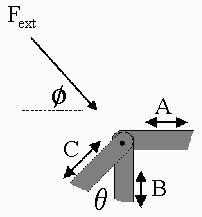 |
For example, in the joint shown to the left, the beams are under compression. Their internal forces, therefore, tend to act against the compression and out against the joint. Static equilibrium demands that  and and . In particular, using the capital letters to denote the magnitude of force along a beam, . In particular, using the capital letters to denote the magnitude of force along a beam,

Because each joint will give such equations, the total number of equations that can be written, under our assumptions, is twice the number of joints. Normally, we are interested in finding the internal beam forces and the reaction forces at the support under some external load. Thus the number of unknowns is the number of beam forces plus the number of reaction forces.
|